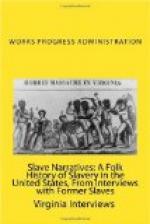Mississippi Federal Writers Slave Autobiographies
CLARA C. YOUNG
Monroe County, Mississippi
Clara G. Young, ex-slave, Monroe County, is approximately 95 years old, about five feet two inches tall, and weighs 105 pounds. She is a frail, dark skinned Negro, with the typical broad nose and the large mouth of the southern Negro. Her physical condition is especially good for a woman of her age. She is very talkative at times, but her memory appears to come and go, so that she has to be prompted at intervals in her story-telling by her daughter or granddaughter, with whom she lives. Familiarly known as “Aunt Classie,” she is very proud of her age and more especially of her long line of descendants.
“Law, Miss, I doan know when I was born, but I do know dat I’se sebenteen years old when I was fust sol’. Dey put me an’ my brudder up on de auction block at de same time. He brung $1400 but I dis’members zactly what dey paid far me. Wa’nt dat much, tho’, fer big strong mans brung mo’ dan wimmens an’ gals.”
Long pauses accentuated the quavery voice of the old Negro, whose head resembled a nappy patch of cotton, and who was so enthusiastic over reminiscing about the days when she was young and carefree.
“I was born in Huntsville, Alabamy, an’ my mammy an’ pappy was name Silby an’ Sharper Conley. Dey tuk de las’ name frum de old marster dat owned ’em. I lived dar wid ’em ’til de chullun drew dey parts an’ us was ’vided out. While I was wid old marster, he let Miss Rachel—dat was his wife—have me fer de house. She larned me how to cook an’ wait on de table, an’ I declar’, she call me her ver’ smartest gal! Sometimes, tho’, I wouldn’ come right quick lak when she ring de bell fer me, an’ she’d start ringin’ it harder an’ harder. I knowed den she was mad. When I’d get dar, she’d fuss at me an’ tu’n my dress up an’ whup me—not hard ’cause she wa’nt so strong—but I’d holler some!
“Dey had a nigger woman to teach all de house darkies how to read an’ write an’ I larned how to sign my name an’ got as fur as b-a-k-e-r in de Blue Back Speller.
“Marse Conley an’ Miss Rachel had fo’ chullun, Miss Mary, Miss Alice, Miss Willie, an’ Marse Andrew, an’ when de time come, dey give me to Marse Andrew. He car’ied me an’ de rest out to Texas whar he thought he would go an’ git rich. We neber stayed long, tho’, fer lots of de niggers runned ‘way to de Free State an’ Marse Andrew didn’ lak dat.
[HW: Pre-War Days]
“It was when he brought us back to Huntsville dat I was sol’. All de white folks was a gittin’ scared dey was gwineter lose dey slaves an’ dere was a pow’ful lot er nigger sellin’ goin’ on den. Marse Ewing bought me frum him an’ car’ied me to his plantation near Aberdeen, Mississippi. Den I started to workin’ in de fiel’ wid de rest of de hands. De oberseer dat we had was right mean to us when we didn’ work our rows as fas’ as de others, an’ sometime he whup us, wimmen an’ all. When he did dat some of us most nigh allus tell de marster an’ he would jump on de oberseer an’ tell him to lay off de wimmen an’ chullun. Dey was allus sort of thoughtful of us an’ we loved old marster.




